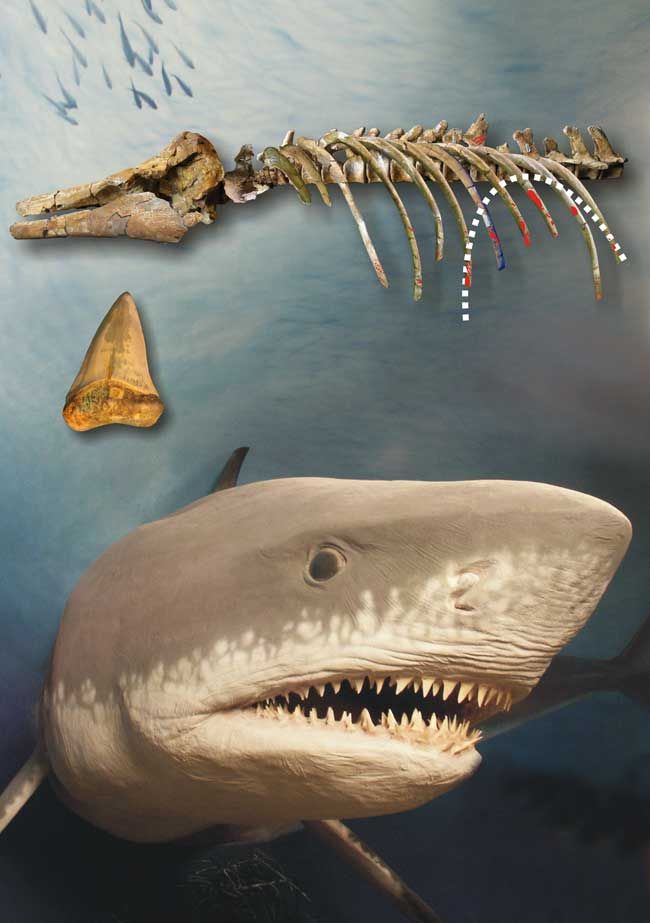Prehistoric Shark Attack Reconstructed

A shark attack that took place 4 million years ago has just been reconstructed from the extinct hunter's fossilized victim – a dolphin.
Scientists investigated a well-preserved 9-foot-long dolphin (2.7 meters) discovered in the Piedmont region of northern Italy. From the remains, the researchers not only finger-pointed the attacker but also how the thrashing went down, suggesting the shark took advantage of the dolphin's blind spot.
"The skeleton lay unstudied in a museum in Torino for more than a century, but when I examined it, as part of a larger study of fossil dolphins, I noticed the bite marks on the ribs, vertebrae and jaws," recalled lead researcher Giovanni Bianucci at the University of Pisa in Italy.
"Identifying the victim of the attack was the easy part — it's an extinct species of dolphin known as Astadelphis gastaldii," he said. "Working out the identity of the killer called for some serious detective work, as the only evidence to go on was the bite marks."
Identifying the culprit
The overall shape of the bite marks indicated a shark attack.
"The smoothness of the bite marks on the ribs clearly shows that the teeth of whatever did the biting were not serrated, and that immediately ruled out some possibilities," said researcher Walter Landini, a fossil shark expert at the University of Pisa in Italy.
Sign up for the Live Science daily newsletter now
Get the world’s most fascinating discoveries delivered straight to your inbox.
They simulated bite marks of potential culprits by pressing their fossil teeth into modeling clay. By comparing these with the shape and size of the marks on the dolphin fossils, the researchers determined the probable identity of the killer as an extinct shark by the name of Cosmopolitodus hastalis, which scientists have recently suggested might have been the ancestor to the modern great white shark.
Fossil teeth from this once-powerful shark are common in the rock sequences where the dolphin was found.
"From the size of the bite, we reckon that this particular shark was about 4 meters long (13 feet)," Landini said.
It remains a mystery why the shark did not finish devouring its prey.
"Dolphins do show protective behaviors, so who knows, maybe other dolphins fought back, and the shark was discouraged," said fossil shark expert Kenshu Shimada at DePaul University and the Sternberg Museum of Natural History, who did not take part in this research.
Reconstructing the attack
Careful analysis of the dolphin remains revealed how the shark might have attacked its prey.
"The deepest and clearest cuts are on the ribs of the dolphin, "indicating the shark attacked from below, biting into the abdomen," Bianucci said.
This surprise attack would have taken advantage of the dolphin's blind spot.
"Caught in the powerful bite, the dolphin would have struggled, and the shark probably detached a big amount of flesh by shaking its body from side to side," he added. "The bite would have caused severe damage and intense blood loss, because of the dense network of nerves, blood vessels and vital organs in this area. Then, already dead or in a state of shock, the dolphin rolled onto its back, and the shark bit again, close to the fleshy dorsal fin."
This kind of fossilized evidence of the behavior of extinct species is extraordinarily rare.
"Studies like this are important, because they give us a glimpse of the ecological interactions between organisms in prehistoric seas," Shimada said. He and his colleagues recently discovered evidence of an ancient shark attack on a giant marine reptile known as a plesiosaur.
"Shark teeth are among the most common vertebrate remains in the fossil record, yet interpreting the details of diet and feeding behavior of extinct sharks is extremely difficult. Fossil remains of prey species with shark-bite marks like those described by Bianucci and his team provide direct evidence of what each prehistoric shark ate and how it behaved."
Bianucci, Landini and their colleague Barbara Sorce detailed their findings in the latest issue of the journal Palaeontology.












